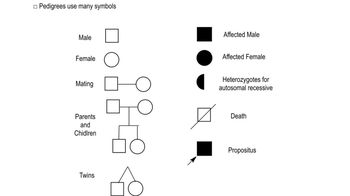A 40-year-old woman whose father had Huntington disease currently shows no symptoms of the disease. She is newly pregnant with her first child and seeks your best estimate of the chance her child will inherit the disease. What is your estimate and how did you arrive at it? (Hint: See Figure 4.11)
Table of contents
- 1. Introduction to Genetics51m
- 2. Mendel's Laws of Inheritance3h 37m
- 3. Extensions to Mendelian Inheritance2h 41m
- 4. Genetic Mapping and Linkage2h 28m
- 5. Genetics of Bacteria and Viruses1h 21m
- 6. Chromosomal Variation1h 48m
- 7. DNA and Chromosome Structure56m
- 8. DNA Replication1h 10m
- 9. Mitosis and Meiosis1h 34m
- 10. Transcription1h 0m
- 11. Translation58m
- 12. Gene Regulation in Prokaryotes1h 19m
- 13. Gene Regulation in Eukaryotes44m
- 14. Genetic Control of Development44m
- 15. Genomes and Genomics1h 50m
- 16. Transposable Elements47m
- 17. Mutation, Repair, and Recombination1h 6m
- 18. Molecular Genetic Tools19m
- 19. Cancer Genetics29m
- 20. Quantitative Genetics1h 26m
- 21. Population Genetics50m
- 22. Evolutionary Genetics29m
2. Mendel's Laws of Inheritance
Probability and Genetics
Problem 6
Textbook Question
A couple with European ancestry seeks genetic counseling before having children because of a history of cystic fibrosis (CF) in the husband's family. ASO testing for CF reveals that the husband is heterozygous for the Δ508 mutation and that the wife is heterozygous for the R117 mutation. You are the couple's genetic counselor. When consulting with you, they express their conviction that they are not at risk for having an affected child because they each carry different mutations and cannot have a child who is homozygous for either mutation. What would you say to them?
 Verified step by step guidance
Verified step by step guidance1
Explain the concept of compound heterozygosity: In cystic fibrosis (CF), a child can be affected if they inherit two different mutations in the CFTR gene, one from each parent. This is known as compound heterozygosity, where the child has two different defective alleles of the same gene.
Clarify the inheritance pattern: CF is an autosomal recessive disorder, meaning that a child must inherit one defective allele from each parent to be affected. The Δ508 mutation and the R117 mutation are both mutations in the CFTR gene, so they can combine to cause CF if inherited together.
Determine the probability of inheritance: Each parent has a 50% chance of passing on their respective mutation to their child. Use a Punnett square to calculate the likelihood of the child inheriting one mutation from each parent. Represent the alleles as follows: Δ508 (father's mutation), R117 (mother's mutation), and normal alleles (N).
Construct the Punnett square: Create a 2x2 grid where the father's alleles (Δ508 and N) are on one axis and the mother's alleles (R117 and N) are on the other axis. Fill in the grid to show all possible combinations of alleles the child could inherit.
Interpret the results: From the Punnett square, identify the probability of the child inheriting both the Δ508 and R117 mutations (compound heterozygosity). Explain that this combination would result in the child being affected by CF, despite the mutations being different. Emphasize the importance of understanding this risk and discuss potential next steps, such as further genetic testing or reproductive options.
 Verified video answer for a similar problem:
Verified video answer for a similar problem:This video solution was recommended by our tutors as helpful for the problem above
Video duration:
4mPlay a video:
Was this helpful?
Key Concepts
Here are the essential concepts you must grasp in order to answer the question correctly.
Cystic Fibrosis Genetics
Cystic fibrosis (CF) is an autosomal recessive disorder caused by mutations in the CFTR gene. For a child to be affected by CF, they must inherit two copies of the mutated gene, one from each parent. In this case, the husband and wife are both carriers of different CFTR mutations, which means they each have one normal and one mutated allele.
Recommended video:
Guided course

Descriptive Genetics
Heterozygosity and Carrier Status
Heterozygosity refers to having two different alleles at a gene locus. In this scenario, both parents are heterozygous for different CF mutations, meaning they are carriers but do not exhibit symptoms of the disease. However, being a carrier still poses a risk for their offspring, as they can pass on the mutated allele to their children.
Recommended video:
Guided course

Pedigree Symbols
Risk of Affected Offspring
The risk of having an affected child is determined by the combination of alleles inherited from both parents. Since the couple carries different mutations, there is a possibility that their child could inherit one mutated allele from each parent, leading to a child who is homozygous for a CF mutation. Therefore, it is essential to explain that while they may not share the same mutation, they still have a risk of having a child with cystic fibrosis.
Recommended video:
Guided course

RNA Interference
Related Videos
Related Practice
Textbook Question
387
views


